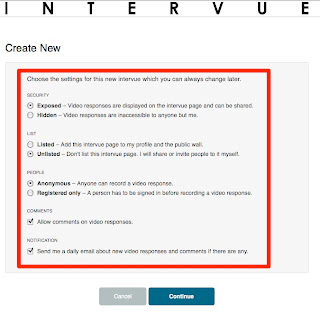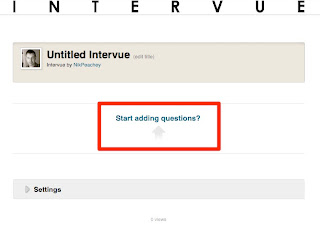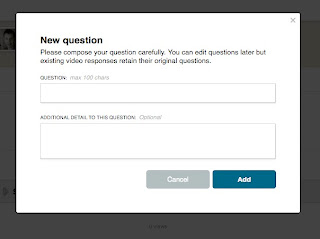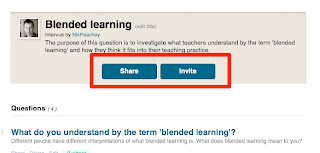Intervue.me is a new website I have been using recently. It's another website that is based around the use of webcams. The site enables users to create questionnaires and then get the recipients of the questionnaire to leave video recorded answers. The site is very easy to use.
Register the go to 'My Dashboard' and click on 'Create New' to start your first questionnaire.

First you decide on the levels of privacy you want for the questionnaire and whether you want people to be able to leave anonymous answers or add comments to the answers.

Next you click on 'Start adding questions'.
 You can type in your question and give more explanation below the question if you think that makes it clearer. You can add as many questions as you want. You'll also need to click on 'Edit title' so that you can give your questionnaire a name.
You can type in your question and give more explanation below the question if you think that makes it clearer. You can add as many questions as you want. You'll also need to click on 'Edit title' so that you can give your questionnaire a name.

Once you have added all your questions you can just click on 'Share' or 'Invite' to either get a URL for your questionnaire or to email it to specific people.

Then once people receive the questionnaire they just click on the questions and record their answers using the webcam in their laptop.
To see all the videos you can just go to 'My Dashboard' and click on the 'Videos' tab.

Here are some example questionnaires I have created. Feel free to leave an answer to any of the questions.
How to use Intervue.me with students
Related links:
Nik Peachey
Register the go to 'My Dashboard' and click on 'Create New' to start your first questionnaire.

First you decide on the levels of privacy you want for the questionnaire and whether you want people to be able to leave anonymous answers or add comments to the answers.

Next you click on 'Start adding questions'.
 You can type in your question and give more explanation below the question if you think that makes it clearer. You can add as many questions as you want. You'll also need to click on 'Edit title' so that you can give your questionnaire a name.
You can type in your question and give more explanation below the question if you think that makes it clearer. You can add as many questions as you want. You'll also need to click on 'Edit title' so that you can give your questionnaire a name.
Once you have added all your questions you can just click on 'Share' or 'Invite' to either get a URL for your questionnaire or to email it to specific people.

Then once people receive the questionnaire they just click on the questions and record their answers using the webcam in their laptop.
To see all the videos you can just go to 'My Dashboard' and click on the 'Videos' tab.

Here are some example questionnaires I have created. Feel free to leave an answer to any of the questions.
How to use Intervue.me with students
- Create comprehension check questions to go with reading homework so that students also do some speaking for homework.
- Create opinion polls for students to answer.
- Make action research questionnaires
- Play the alibi game and get students to explain where they were and what they were doing at particular points in time.
- Ask students about childhood memories.
- It's very quick and easy to create questionnaires
- It's a great way to provide speaking practice for students.
- You can add more detail and explanation to the questions.
- Students get to practice their digital communication skills.
- Students will be able to watch and listen to their replies and rerecord them so this will focus them on accuracy.
- It can be more communicative and engaging than writing down answers as students can also see the other answers that have been recorded.
- You can create long questionnaires or very simple single question ones.
- It could take time to get students feeling comfortable in front of the camera, so you might need to help them a little and get them to think about lighting and getting the correct distance from the camera.
- Be careful about enabling anonymous replies or comments as this could be abused.
- Students need a laptop with a reasonable quality microphone.
Related links:
- Create a Video Q&A Booth
- So Ask Me a Question
- Create a Video Dictation Activity
- 20 WebCam Activities for EFL ESL Students
- Teach Yourself to Teach with Tech
- Get your Students Listening and Interacting with Native Speakers
Nik Peachey







